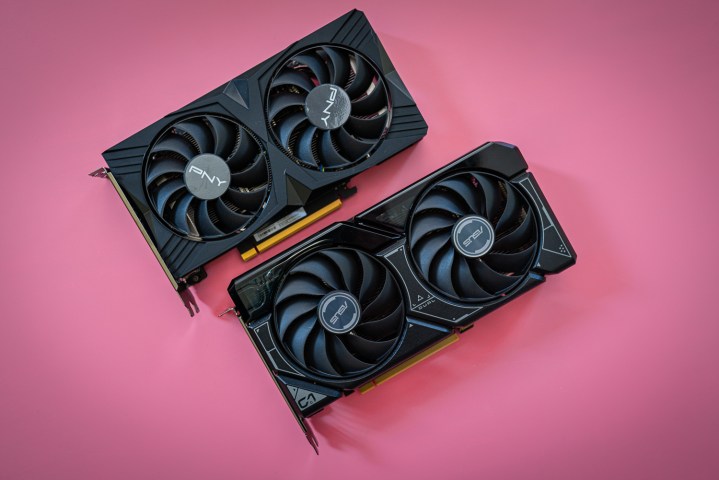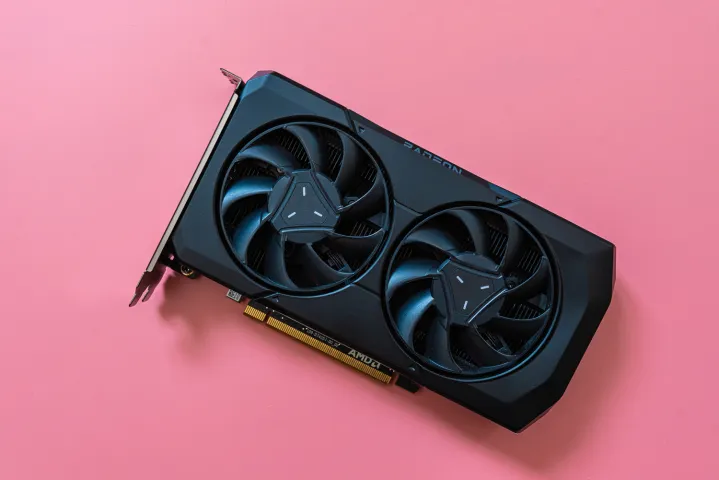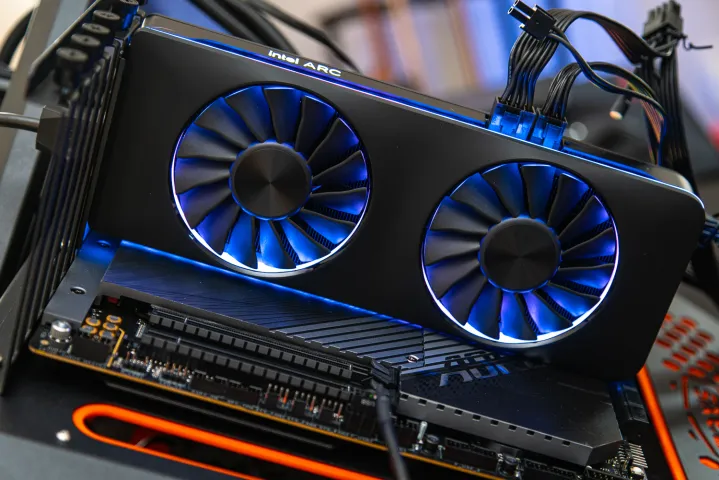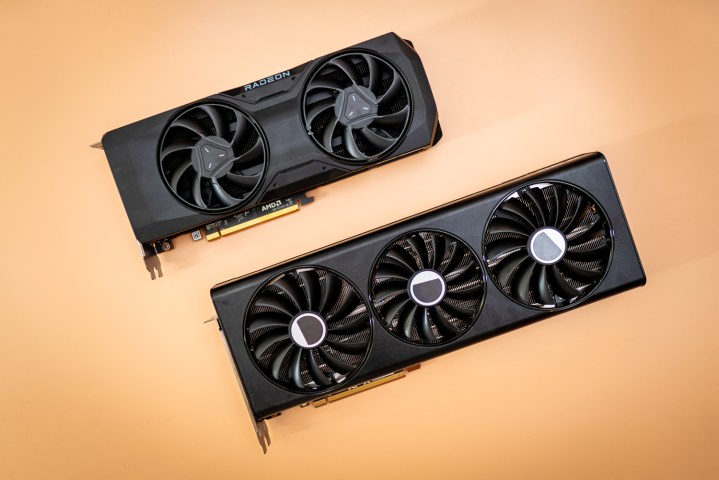
If you’re in the market for a budget GPU, the RTX 4060 is one of the best graphics cards you can buy. It’s available for a reasonable price, offers solid 1080p performance, and comes with a suite of Nvidia-exclusive features. Still, it’s not the right graphics card for everyone.
As you can read in our RTX 4060 review, Nvidia’s value-focused GPU has a few minor issues. It’s still a card to keep in mind if you’re shopping for a budget graphics card, but we rounded up five alternatives that fill in the gaps that the RTX 4060 leaves.
AMD RX 7600

The most direct competition to the RTX 4060 is AMD’s RX 7600. It’s about 10% slower than the RTX 4060, and it lacks Nvidia’s impressive DLSS 3.5, but it also comes in between $250 and $270. In many titles, the RX 7600 is faster, too.
For instance, in Cyberpunk 2077, we found that the RX 7600 was around 6% faster than the RTX 4060. In games like Returnal and Horizon Zero Dawn, the two GPUs are evenly matched. The RX 7600 even holds up in lighter ray tracing games like Resident Evil 4 and Returnal, though it’s a decent clip behind what Nvidia currently offers.
Performance is solid considering the price, trading away some of Nvidia’s more premium features for a pure focus on value. Although the RX 7600 doesn’t have access to features like DLSS 3, it still comes with AMD’s robust driver suite. That includes features like AMD Fluid Motion Frames (AFMF) to add frame generation to almost any DirectX 11 or 12 game, as well as Smart Access Memory if you pair the card with an AMD CPU.
The RX 7600 excels as a workhorse that does exactly what you need it to do. It can play the most demanding games available today at 1080p, and with high frame rates. You might not be able to push into the premium territory of ray tracing in all titles, but for value-seekers, there’s not much more you could ask for.
Intel Arc A770

Although a lot of the GPU battle is focused around AMD and Nvidia, you shouldn’t ignore Intel. The Arc A770 is a very compelling graphics card at $300, especially if you’re in the market for the RTX 4060. It delivers largely the same performance at 1080p, including in games with ray tracing, and it comes with a critical 16GB of VRAM.
Over the past couple of years, VRAM has been a big point of contention on budget graphics cards. That’s one of the key issues with the RTX 4060 and RTX 4060 Ti, with modern games stressing their 8GB frame buffer, even at 1080p. The Arc A770 doesn’t have that issue with a massive 16GB of VRAM. Even compared to AMD, 16GB of VRAM is unheard of at $300.
As mentioned, performance holds up, as well. In our testing, the RTX 4060 and Arc A770 trade blows in most games. In some titles, like Cyberpunk 2077, Intel comes out ahead by a few frames. In others, such as Returnal, Nvidia comes out ahead by a few frames. Overall, however, you’re getting largely similar performance with both GPUs.
Buying into Intel is a bit risky, as the Arc A770 is the company’s first-ever discrete graphics card. As we’ve seen over the last several months, however, Intel continues to push out driver updates that improve performance across games and fix various issues. It’s much easier to recommend the Arc A770 today than it was a year ago.
Nvidia RTX 3070

The RTX 3070 destroys the RTX 4060. They’re not even in the same class of GPU in terms of performance, and if you can find an RTX 3070, it’s definitely the GPU to pick up. The only caveat is, well, finding an RTX 3070. Most of them are sold out at retailers, and if you happen to find one in stock online, you’ll often spend around $500.
However, you can find them readily available on the secondhand market for around $280 to $350. If you’re especially lucky, you might even be able to find an RTX 3070 Ti around the same price. For that, you’re getting a GPU that’s around 20% faster than the RTX 4060 at 1080p, giving you enough grunt to scale up to 1440p.
You still have access to most of Nvidia’s features, too. DLSS Super Resolution is available on the RTX 3070, boosting your performance even higher, and ray tracing performance is off the charts. The only downside is that you can’t access DLSS Frame Generation with the RTX 3070 in demanding games like Cyberpunk 2077 and Alan Wake 2.
The RTX 3070 makes up for it with much higher performance, however. Buying a secondhand GPU isn’t for everyone, as you’ll need to vet both the product and the seller, but if you’re willing to be patient and seek out a good deal, the RTX 3070 is worth every penny.
AMD RX 6800

If the RTX 3070 sounds like your deal but you don’t want to deal with the secondhand market, AMD’s RX 6800 is for you. You can still find this last-gen GPU in stock for around $370, and it’s just as fast as the RTX 3070. You’re getting around a 20% performance boost over the RTX 4060 overall, and around a 35% boost if you ignore ray tracing.
That’s where the RX 6800 shines the most. AMD’s last-gen GPUs aren’t the best when it comes to ray tracing, but they’re extremely powerful in rasterized games. You’re getting a lot more performance for your dollar with the RX 6800 compared to the RTX 4060, and with 16GB of VRAM in tow. Performance at 1080p is great, but there’s enough juice here to go up to 1440p and maybe even 4K.
On top of great performance, you still have access to AMD’s AFMF feature if you want to dabble in titles with demanding ray tracing, as well as the other features available in AMD’s performance suite. Nvidia has a solid suite of features, as well, but AMD still holds the lead when it comes to performance monitoring and GPU overclocking through its software.
The RX 6800 was the odd card out of AMD’s last-gen lineup, but a cascade of price drops over the past year have left it in a much better spot. It also wasn’t very popular in the previous generation, with most gamers opting for the more powerful RX 6800 XT instead. Thankfully, that means there’s plenty of backstock to pick from.
AMD RX 7700 XT

The RX 6800 was the odd card out during the previous generation, and the RX 7700 XT is the equivalent of this generation. It wasn’t a very good GPU when it released, coming in too expensive for the performance it offered and too close in price to AMD’s much more impressive RX 7800 XT. Thankfully, the situation has changed over the past few months with the RX 7700 XT coming down in price.
You can find it for around $400 now, and even as low as $370 on sale. That’s quite a bit more expensive than the RTX 4060, but the RX 7700 XT is also quite a bit faster. Based on our testing, it’s anywhere from 25% to 30% faster than the RTX 4060, and that includes titles with ray tracing. Without ray tracing, the RX 7700 XT shoots even further ahead.
As with the previous AMD recommendations, there are a few things to keep in mind. You don’t have access to DLSS 3.5 here, but AFMF is there to fill in the gaps. Ray tracing performance generally takes a backseat, too, though the raw performance advantage of the RX 7700 XT is enough to make up for that gap.
Editors' Recommendations
- Nvidia could flip the script on the RTX 5090
- 4 CPUs you should buy instead of the Intel Core i9-13900K
- AMD’s graphics card sales just took a nosedive
- 4 CPUs you should buy instead of the Ryzen 7 7800X3D
- The war between PC and console is about to heat up again




